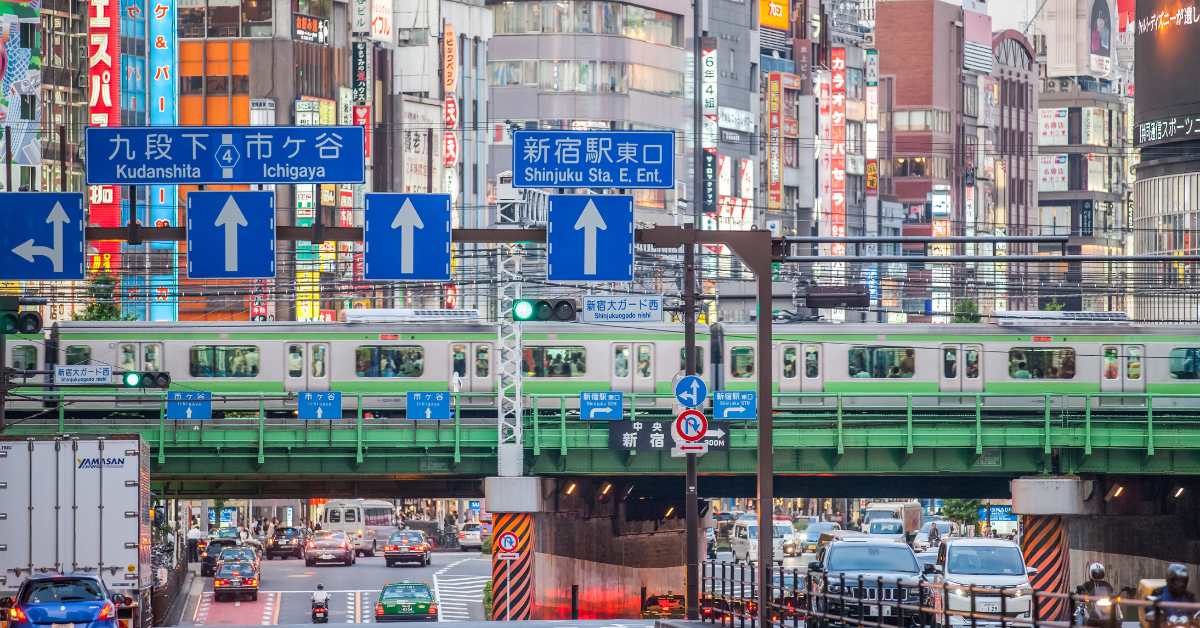The film Your Name. features many real-life landscapes. Among them, the traffic light behind Shinjuku Police Station stands out in the scene where Taki chats with his friend after work. For fans, this spot is an essential stop in their pilgrimage, allowing them to experience the everyday realism of the film’s world.
The Scene Featuring the Traffic Light Behind Shinjuku Police Station
In Your Name., the traffic light behind Shinjuku Police Station is depicted as a symbolic stage of Taki’s everyday life. The scene shows Taki finishing his part-time job, walking with a friend, and chatting casually. Unlike famous landmarks, the chosen backdrop is an ordinary city intersection. Director Makoto Shinkai intentionally selected it to highlight the film’s themes of “realism” and “the beauty of everyday life.”
Though brief, this moment resonates deeply. For viewers, it feels as though they could easily overlap their own routines with Taki’s, providing a strong sense of self-projection into the story. The bustle of the city blends seamlessly with youthful conversation, giving the narrative a natural credibility.
Location and Access
The traffic light behind Shinjuku Police Station is located in the heart of Tokyo’s Shinjuku district. Thanks to its proximity to Shinjuku Station, one of Japan’s busiest hubs, the site is highly accessible and makes an ideal starting point for a pilgrimage.
| Transportation | Travel Time | Key Feature |
|---|---|---|
| Walk from Shinjuku Station West Exit | About 7 min | Transition from bustling station area to quieter backstreets |
| Walk from Seibu Shinjuku Station | About 5 min | Route passes close to Kabukicho |
| Walk from Toei Oedo Line Shinjuku-Nishiguchi Station | About 6 min | Convenient for subway users |
Ease of access is a major advantage, making it a popular stop even for casual visitors.
The Appeal as a Film Setting
Although not a famous landmark, this traffic light became a symbolic cinematic backdrop. Because it represents an ordinary urban space, audiences can easily connect it to their own lives, creating a stronger attachment to the story.
Visiting at night enhances the experience, as the glow of the signal and the neon lights overlap, recreating the film’s unique atmosphere. During the day, the busy flow of people and vehicles reflects Tokyo’s everyday energy, offering a different but equally compelling impression.
| Time of Visit | Atmosphere | Recommended Highlight |
|---|---|---|
| Day | Everyday life of Tokyo on full display | Best for experiencing realistic detail |
| Evening | Contrast of light and shadow | Closest to the cinematic look |
| Night | Signal lights and neon create a dreamy mood | Ideal for photography |
Visiting at multiple times of the day reveals dramatically different impressions, adding depth to the experience.
Nearby Attractions
Shinjuku is one of Japan’s largest entertainment districts, so exploring nearby areas enhances the pilgrimage.
| Spot | Feature | Distance |
|---|---|---|
| Omoide Yokocho | Retro alley filled with small eateries | About 8 min walk |
| Kabukicho | Packed with theaters and nightlife spots | About 10 min walk |
| Shinjuku Central Park | Green oasis for relaxation | About 12 min walk |
Omoide Yokocho is especially recommended after visiting the site, offering Showa-era nostalgia and authentic local food.
Tips for Visiting the Sacred Site
Because the site is right behind Shinjuku Police Station, certain considerations are necessary.
- The intersection is very busy, so safety must always come first when taking photos
- Being near a police station, avoid standing too long or blocking pathways
- Respect pedestrians and residents, and practice good manners during the pilgrimage
For fans, this is a meaningful site, but it’s also part of everyday Tokyo, so awareness of context is essential.
A Unique Fan Experience
For fans, visiting the traffic light is more than sightseeing—it is a personal act of connecting memories with the film.
- Standing at the same crosswalk where Taki did
- Imagining walking alongside a friend, just like in the movie
- Experiencing the city sounds and light changes, reliving the film’s atmosphere
These moments create a sensory memory that goes beyond watching the film. For many fans, the pilgrimage becomes a ritual that strengthens their bond with the story.
Comparing the Shinjuku Traffic Light with Other Sacred Sites
Your Name. features several sacred locations, each with its own role in the story.
| Sacred Site | Scene | Distinctive Feature |
|---|---|---|
| Shinjuku Police Station Traffic Light | Taki chats with his friend after work | Represents Tokyo’s everyday life |
| Yotsuya Suga Shrine Staircase | Taki and Mitsuha reunite in the climax | The film’s most iconic site |
| Shinanomachi Overpass | Taki walking with Okudera-senpai | Symbol of modern Tokyo |
| Tateishi Shopping Street | Mitsuha’s daily life with family and friends | Depicts rural lifestyle |
The Shinjuku traffic light may not host the climax, but it plays a vital role in grounding the film’s realism.
How to Enhance the Pilgrimage Experience
A few thoughtful preparations can make the visit more rewarding.
| Method | Benefit |
|---|---|
| Re-watch the specific film scene before visiting | Easier to match visuals to reality |
| Visit both day and night | Compare contrasting atmospheres |
| Record not only photos but also video | Capture the sounds and movements |
| Keep a pilgrimage journal | Helps preserve personal impressions |
Adding personal touches transforms the visit from a simple stop into a lasting memory.
Conclusion
The traffic light behind Shinjuku Police Station in Your Name. serves as a powerful symbol of urban realism. Though modest in appearance, it has become unforgettable for fans worldwide.
It is a key backdrop supporting the film’s authenticity, allowing visitors to relive fleeting moments of youth.
With easy access and plenty of attractions nearby, this sacred site is a must-visit for anyone seeking to dive deeper into the world of Your Name.






